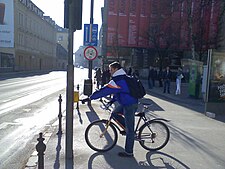Tag:bicycle=optional_sidepath
| Description |
|---|
| Optional (none compulsory) cycleway aside |
| Group: restrictions |
| Used on these elements |
| Useful combination |
|
| Status: in use |
| Tools for this tag |
|
This tag bicycle=optional_sidepath applies only to roads with a classification that allows cycling generally.
When a road has a parallel compulsory cycleway (e.g. ![]() (DE, PL),
(DE, PL), ![]() (DE, FI, IT, PL),
(DE, FI, IT, PL), ![]() (NL) or
(NL) or ![]() (several European countries)) bicycle=use_sidepath must be applied.
(several European countries)) bicycle=use_sidepath must be applied.
When a road has a parallel optional cycleway (e.g. without ![]() ,
,![]() or
or ![]() in DE or a special sign for optional cyceways e.g.
in DE or a special sign for optional cyceways e.g. ![]() (NL) or
(NL) or ![]() (FR, AT)) bicycle=optional_sidepath can be applied.
(FR, AT)) bicycle=optional_sidepath can be applied.
But only when this road does not have a traffic sign which explicitly forbids bicycling (e.g. ![]() or
or ![]() ). In that case use bicycle=no.
). In that case use bicycle=no.
How to tag
This tag indicates whether cycle ways are not compulsory.
cycleway=separate (cycleway:left=separate / cycleway:right=separate / cycleway:both=separate variants) may indicate, if a separate (cycle)way is drawn there. But it does not make any statement about whether that separately mapped cycle path is compulsory or not.
bicycle=use_sidepath should not be used in combination with cycleway=track or cycleway=lane on the main highway, if there is no separate cycleway drawn on the map, because this may confusing routing engines. bicycle=optional_sidepath should not cause this problem, so it may be used in this combinations, too. But be aware, that solving this routing problem by finding another solution for bicycle=use_sidepath in this combinations may also change the use of bicycle=optional_sidepath for this combinations.
Because bicycle=optional_sidepath may be used also in cases, where the alternative way nearby may be not only a cycleway, but also a sidewalk, where cyclists are allowed, or a track, cycleway=separate still may be usefull.
To indicate a one-way optional cycleway use a directional subkey, e.g. bicycle:forward=optional_sidepath. Choose between :forward and :backward depending on the optional cycle direction relative to the direction of the OSM way ![]() for the main road. The cycleways OSM direction is not important.
for the main road. The cycleways OSM direction is not important.
In some countries compulsory and none compulsory cycleways are divided by different signs:
- France, Austria, ...: compulsory:
 versus none compulsory:
versus none compulsory: 
- Netherlands: compulsory:
 versus none compulsory:
versus none compulsory: 
In some countries compulsory and none compulsory cycleways are divided by law:
- Germany: compulsory:
 ,
,  or
or  versus none compulsory: without this signs, but still identifiable as cycleway, that might be
versus none compulsory: without this signs, but still identifiable as cycleway, that might be
- a segregration of footway and cycleway by different colors of paving stones or a white line like used for

- a white sign on the ground, that looks like a
 (see here) or without a pedestrian symbol,
(see here) or without a pedestrian symbol, - a road sign
 without(!)
without(!)  or
or  or something similar, that looks like a
or something similar, that looks like a  , but black on white
, but black on white - might be also (but unsure): a passage for cyclists leading on the way, guideposts, ...
- a segregration of footway and cycleway by different colors of paving stones or a white line like used for
This cases are none compulsory, but still designated for cyclists
Other cases of optional sidepaths:
- Germany:
For all cases: The cycleway should clearly belong to the total street. If it is to far away from the street and does not share the same crosings, it ist not the cycleway of this street, but a separate cycleway and the main highway should not get bicycle=use_sidepath or bicycle=optional_sidepath.
Examples
| Picture | Tags |
|---|---|
 This cycleway is compulsory. |
Cycleway: highway=cycleway (implicit:bicycle=designated) Main road: bicycle=use_sidepath |
or  (FR, AT) (FR, AT)or  or or  (DE) (DE)These cycleways are not compulsory. Cycling is allowed on the adjacent roads, too. |
Cycleway: highway=cycleway Main road: bicycle=optional_sidepath |
 In this street, cycling is explicitly not allowed on the "road" (carriageway). |
highway=* bicycle=no (explicit bicycle ban) |
Supportmap
In Germany since Juli 2022 this map shows use_sidepath and optional_sidepath.
Statistics
| bicycle=optional_sidepath | |
| bicycle:forward=optional_sidepath | bicycle:backward=optional_sidepath |
History
In 2017 User:Schienennagelhammerträger started using this tagging in his former home city because of a high percentage of none compulsory cycleways there to distinguish them from compulsory cycleways. After spreading this tagging into other regions by other users e.g. Berlin, it is time to say, that it is "in use".
